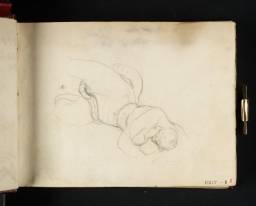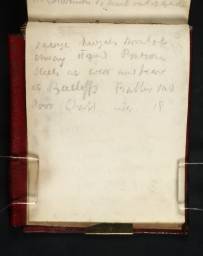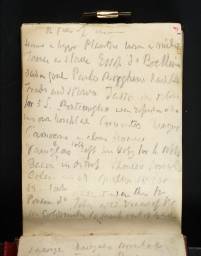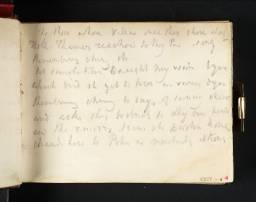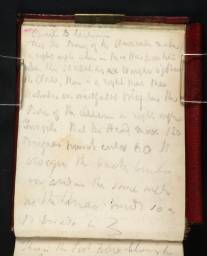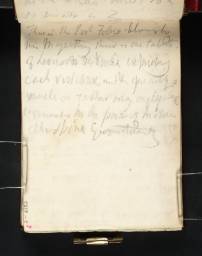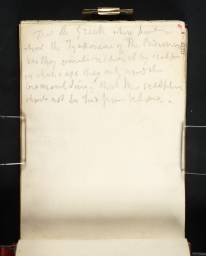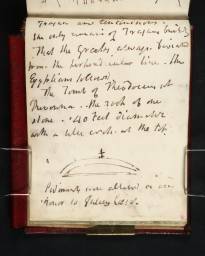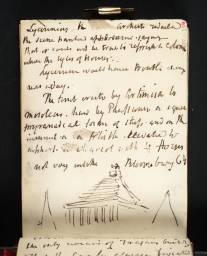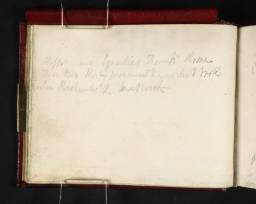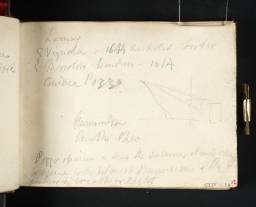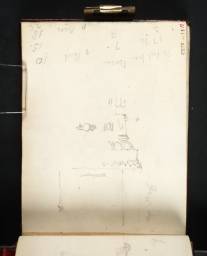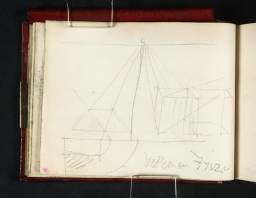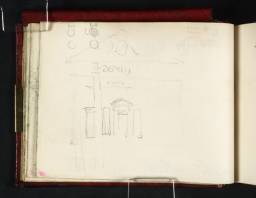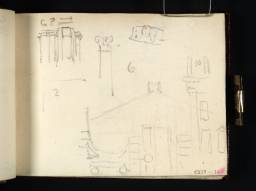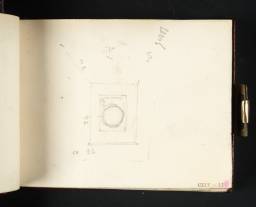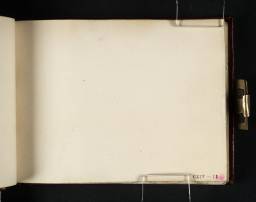Turner Bequest CXIV 1–86a
Sketchbook bound in boards, covered in reddish-brown leather with blind-stamped decorative borders and a brass clasp; leather pencil loop along full length of top edge of front cover; bellows-type pocket inside back cover
86 leaves and pastedowns of white wove Whatman paper; various sheets watermarked ‘J Whatman | 1808’; outer edges mottled blue-grey; page size 87 x 117 mm
Inscribed by Turner ‘– 56 –’ on label (now lost, but formerly pasted to the spine)
Numbered 208 as part of the Turner Schedule in 1854 and endorsed by the Executors of the Turner Bequest inside front cover (D07958)
86 leaves and pastedowns of white wove Whatman paper; various sheets watermarked ‘J Whatman | 1808’; outer edges mottled blue-grey; page size 87 x 117 mm
Inscribed by Turner ‘– 56 –’ on label (now lost, but formerly pasted to the spine)
Numbered 208 as part of the Turner Schedule in 1854 and endorsed by the Executors of the Turner Bequest inside front cover (D07958)
Accepted by the nation as part of the Turner Bequest 1856
Exhibition history
References
This sketchbook is miscellaneous in character, comprising studies for Sandycombe Lodge, Turner’s self-designed house in Twickenham, landscape subjects west of London, notes and architectural studies relating to the artist’s 1811 Royal Academy perspective lectures, and other miscellaneous notes and studies as set out below. It has been assigned to the Sandycombe section of the present catalogue, along with the Sandycombe and Yorkshire sketchbook (Tate; Turner Bequest CXXVII) and two separate working sheets (see the overall Introduction to the section).
Finberg dated the sketchbook to around 1810–11, while more recently Andrew Wilton has suggested 1812,1 and Ian Warrell about 1810.2 In view of various factors mentioned below, it is dated in the present catalogue to about 1808–11, with individual pages dated more specifically where possible. Eric Shanes has suggested the main Sandycombe design campaigns fell between ‘the summer of 1809 and the early autumn of 1811’,3 and these year dates have been adopted for the relevant works in the present sketchbook. The relevant pages are as follows, although it should be noted that Turner appears to have worked inwards from the back of the sketchbook:
folios 73 verso–74 recto, 74 verso, 75 verso–76 recto, 77 verso, 78 recto and verso, 79 recto (comprising notes alone), 79 verso, 80 verso, 81 verso, 82 recto and verso, 83 verso, 84 recto, 84 verso, 85 verso and 86 verso (D08057–D08059, D08061, D08062, D08065–D08069, D08071, D08073–D08075, D08077–D08079, D08081, D08083)
There are numerous landscape studies, occupying several pages from folios 28 recto to 38 recto (D07999–D08010), and from folios 70 recto to 73 recto (D08051–D08056). The last of the earlier sketches show the River Brent, north-west of London, which merges with the Grand Union Canal at Hanwell, traditionally the main subject of the second grouping. As discussed under D08055 (CXIV 72a), Turner appears to refer the canal subject in notes elsewhere in 1808, thus suggesting the earliest date that the present sketchbook, watermarked 1808, was in use. There is also a landscape sketch inside the front cover (D07958).
Maurice Davies notes that Turner made other early research notes on the history of perspective from Joseph Priestley’s The History and Present State of Discoveries Relating to Vision, Light and Colours (London 1772), and from various early treatises in the British Museum (now held at the British Library, London) in the Greenwich and Perspective sketchbooks (Tate; Turner Bequest CII, CVIII). In the present book, the main source is John Joshua Kirby’s Dr Brook Taylor’s Method of Perspective Made Easy both in Theory and Practice (Ipswich 1754 and London 1768 editions).4 The relevant folios are 11 verso, 12 recto, 13 verso, and 14 recto and verso (D07975, D07976, D07979–D07981). Davies states that these notes date from 1809, as they informed the First Draft of Turner’s third perspective lecture.5
There are further perspective notes and diagrams:
folios 4 verso, 8 recto, 9 recto and verso, 10 recto, 11 verso, 12 recto, 13 verso, 14 recto and verso, 20 verso, 21 recto and verso, 22 recto, 45 verso, 46 recto, 50 verso, 51 recto, 65 recto and verso and 69 verso (D07965, D07970–D07973, D07975, D07976, D07979–D07981, D07990–D07993, D08018, D08019, D08025, D08026, D08044, D08045, D08050)
Turner also made studies of four prominent classical buildings in London, informing the large watercolour diagrams for his first lecture as Professor of Perspective at the Royal Academy in January 1811:6
On folios 2 verso and 3 recto (D07962, D07963) are historical notes on the hardships of writers, derived from a text by Oliver Goldsmith, while folios 6 verso and 7 recto (D07968, D07069) comprise notes from a Royal Academy anatomy lecture by Sir Anthony Carlisle. Two drafts of Turner’s own poetry, concerning Alexander Pope, are on folios 4 recto and 77 recto (D07964, D08064). There are also brief miscellaneous notes inside the front and back covers (D07958, D07959). In a rather different mode, at the beginning of the book are two extremely slight drawings apparently of erotic subjects, and one unambiguous sketch of a woman entwined with a snake (folios 1 recto and verso, and 2 recto; D07960, D40812, D07961).
Technical notes
How to cite
Matthew Imms, ‘Windmill and Lock sketchbook c.1808–11’, sketchbook, January 2012, in David Blayney Brown (ed.), J.M.W. Turner: Sketchbooks, Drawings and Watercolours, Tate Research Publication, December 2012, https://www



